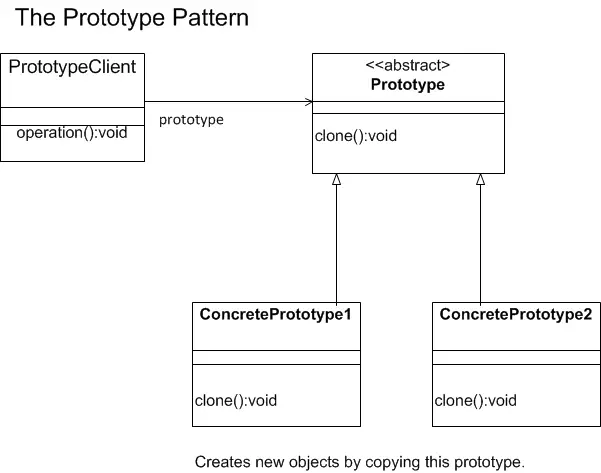Journey through Creation: The Tale of the Prototype Pattern
In the vast realm of software architecture, where ideas are birthed and transformed into tangible digital realities, creational design patterns emerge as the guiding constellations. These patterns, like age-old myths, are tales about the origins of objects, revealing the secrets of their creation. Among these tales, the story of the Prototype Pattern is uniquely fascinating, for it speaks of the power of duplication.
Once upon a time in the digital universe, there arose a challenge. Systems often faced the intricate dilemma of creating new objects that were almost identical to existing ones, but with subtle variations. To reinitiate the entire creation process was not only cumbersome but also inefficient. Thus, the realm yearned for a way to clone what already existed, allowing for minor modifications where needed.
From this enigma, the Prototype Pattern was born.
From this enigma, the Prototype Pattern was born.
The Essence of the Prototype
Instead of forging anew, the Prototype Pattern proclaimed, "Let objects create copies of themselves!" At its core, this pattern emphasized the ability of an object to create a clone of itself. This ensured that if a system had an instance of an object, it didn't need to revisit the arduous creation process. Instead, it could simply ask the object for a copy, adjusting the clone as necessary.
Key Characters of the Tale
- Prototype Interface: The ancient contract that all prototypes must honor. It dictates that every prototype should have a method to replicate itself.
- Concrete Prototypes**: These are the tangible entities, each promising to fulfill the mandate of the Prototype Interface. When summoned, they dutifully create copies of themselves.
The Adventure in Practice
Imagine a mystical land where enchanted trees thrived. Each tree was unique, yet they shared many characteristics. If a gardener wished to plant a forest with trees resembling a specific enchanted tree but with slight variations, invoking the Prototype Pattern would be a masterstroke. Instead of growing each tree from a seed, the gardener could clone the chosen tree and make the necessary alterations to the offspring.
Position in the Creational Pantheon
In the grand theater of creational patterns, while the Builder meticulously crafts and the Factory Method methodically manufactures, the Prototype effortlessly replicates. It addresses a distinct niche, ensuring that when objects with shared configurations are needed, systems can avoid the overhead of 'creation from scratch' and instead, capitalize on the power of duplication.
As our narrative unfolds, it becomes evident that the Prototype Pattern isn't just a method; it's a philosophy. A philosophy that suggests that sometimes, the most efficient path to creation is not to start from the beginning, but to build upon what already exists. In the dynamic tapestry of software design, the Prototype Pattern is a testament to both the ingenuity of replication and the versatility of adaptation.
The Prototype pattern allows an object to create customized objects without knowing their exact class or the details of how to create them.It specifies the kinds of objects to create using a prototypical instance, and creates new objects by copying this prototype. The Prototype pattern works by giving prototypical objects to an object and then initiates the creation of objects. The creation-initiating object then creates objects by asking the prototypical objects to make copies of themselves. The Prototype pattern makes creating objects dynamically easier by defining classes whose objects can duplicate themselves.

Benefits of the Prototype Pattern:
The following lists the benefits of using the Prototype pattern:
- Adding and removing products at run time.
- Specifying new objects by varying values.
- Specifying new objects by varying structure
- Reduced subclassing
- Configuring an application with classes dynamically
When To Use the Prototype Pattern:
- The classes to instantiate are specified at run time, for example, by dynamic loading.
- To avoid building a class hierarchy of factories that parallels the class hierarchy of products
- When instances of a class can have one of only a few different combinations of state
The prototype pattern is a creational design pattern used in software development when the type of objects to create
is determined by a prototypical instance, which is cloned to produce new objects. This pattern is used to:
- avoid subclasses of an object creator in the client application, like the abstract factory pattern does.
- avoid the inherent cost of creating a new object in the standard way (e.g., using the 'new' keyword) when it is prohibitively expensive for a given application.
To implement the pattern, declare an abstract base class that specifies a pure virtual clone() method.
Any class that needs a "polymorphic constructor" capability derives itself from the abstract base class, and implements the clone() operation.
The client, instead of writing code that invokes the "new" operator on a hard-coded class name, calls the clone() method on the prototype, calls a factory method with a parameter designating the particular concrete derived class desired, or invokes the clone() method through some mechanism provided by another design pattern.
The client, instead of writing code that invokes the "new" operator on a hard-coded class name, calls the clone() method on the prototype, calls a factory method with a parameter designating the particular concrete derived class desired, or invokes the clone() method through some mechanism provided by another design pattern.
Prototype Pattern Java Code